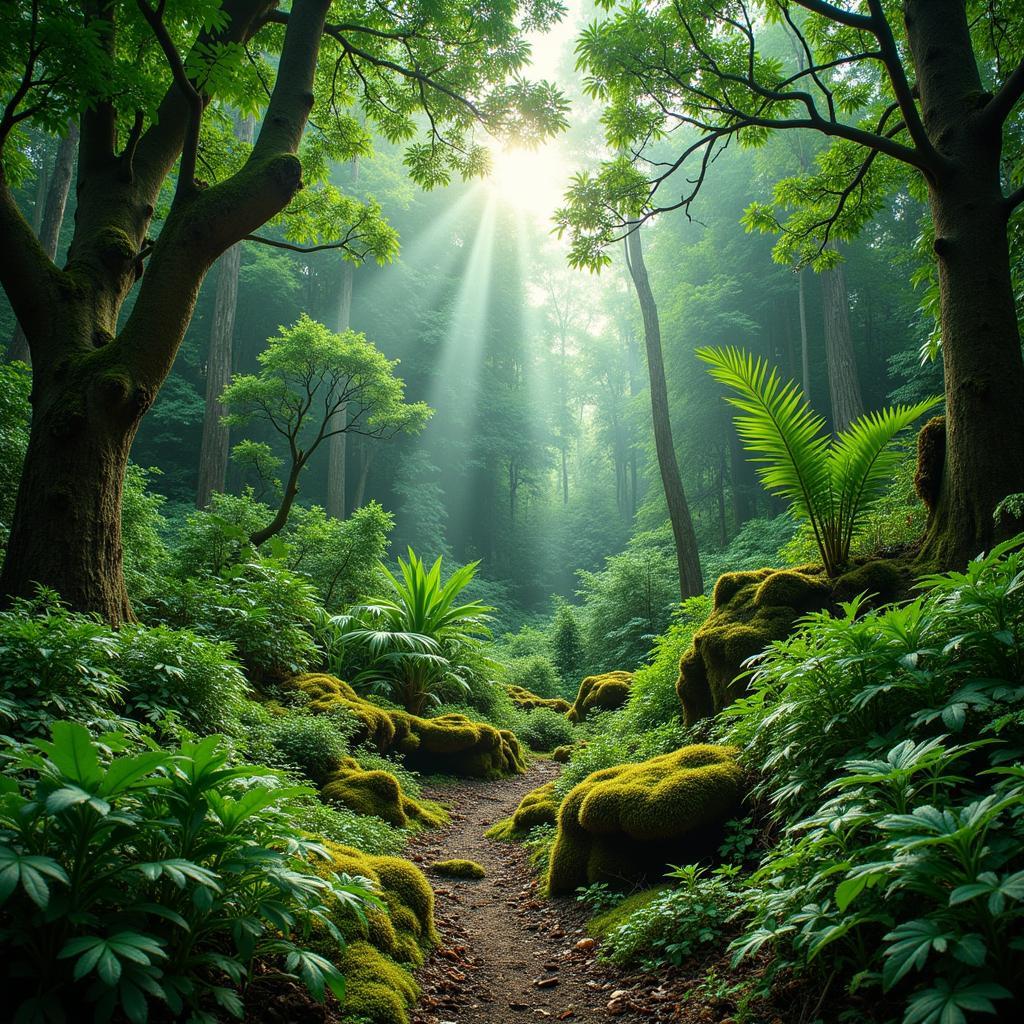The Daintree Rainforest, a UNESCO World Heritage site, boasts a complex and fascinating food chain. From tiny insects to apex predators, every organism plays a vital role in this intricate web of life. Let’s delve into the interconnectedness of this ancient ecosystem and discover the wonders of the Daintree Rainforest Food Chain.
Producers: The Foundation of the Daintree Rainforest Food Chain
The Daintree’s lush vegetation forms the base of its food chain. Plants, algae, and cyanobacteria are the primary producers, converting sunlight into energy through photosynthesis. These organisms provide the essential nutrients and energy that fuel the entire ecosystem. From towering canopy trees like the bull kauri to the diverse array of ferns and mosses on the forest floor, these producers support a vast array of life. They are the foundation upon which the entire Daintree rainforest food chain rests.
The diversity of plant life is astonishing. Consider the strangler fig, which begins life high in a host tree’s canopy, sending down roots that eventually engulf and replace the host. This unique life cycle contributes to the constant cycle of growth and decay that enriches the rainforest soil.
 Daintree Rainforest Producers: Plants and Algae
Daintree Rainforest Producers: Plants and Algae
Herbivores: The Rainforest’s Plant-Eaters
A myriad of herbivores thrives in the Daintree, feasting on the abundant plant life. These creatures range from tiny insects like the Ulysses butterfly, with its vibrant blue wings, to larger animals like the Bennett’s tree-kangaroo, which navigates the canopy with remarkable agility. Insects play a crucial role in pollination and seed dispersal, further contributing to the rainforest’s vibrant biodiversity.
The musky rat-kangaroo, a small and elusive creature, forages for fruits and fungi on the forest floor, while the green ringtail possum prefers the leaves and flowers of the canopy trees. Each herbivore has adapted to its specific niche, contributing to the delicate balance of the Daintree rainforest food chain.
Carnivores: The Daintree’s Apex Predators
At the top of the Daintree rainforest food chain are the carnivores, the predators that keep the herbivore populations in check. The estuarine crocodile, a formidable apex predator, lurks in the rivers and estuaries, ambushing unsuspecting prey. The amethystine python, Australia’s largest snake, constricts its prey, consuming everything from small mammals to birds. Even seemingly harmless creatures like the giant green tree frog play a role as carnivores, feeding on insects and other invertebrates.
The Boyd’s forest dragon, a beautifully camouflaged lizard, patiently stalks insects among the foliage, while various raptors, like the white-bellied sea-eagle, soar through the skies, hunting for fish and other small animals. These predators maintain the balance of the ecosystem, ensuring the health and stability of the Daintree rainforest food chain.
What are the key components of the Daintree Rainforest food chain?
The key components are the producers (plants), herbivores (plant-eaters), and carnivores (meat-eaters), all interconnected in a delicate balance.
How does the Daintree Rainforest food chain work?
Energy flows from the sun to the plants, then to the animals that eat the plants, and finally to the animals that eat other animals.
Conclusion: The Intricate Web of Life in the Daintree Rainforest
The Daintree rainforest food chain is a testament to the interconnectedness of life. From the smallest insects to the largest predators, every organism plays a crucial role in maintaining the delicate balance of this ancient ecosystem. Understanding the daintree rainforest food chain allows us to appreciate the complexity and beauty of this remarkable natural wonder and the importance of its conservation.
FAQ
- What is the largest predator in the Daintree Rainforest? The estuarine crocodile.
- What is a primary producer? Plants, algae, and cyanobacteria that convert sunlight into energy.
- What role do insects play in the Daintree? Pollination and seed dispersal.
- What is an example of a herbivore in the Daintree? The Bennett’s tree-kangaroo.
- Why is the Daintree Rainforest food chain important? It maintains the balance of the ecosystem.
- What threatens the Daintree Rainforest food chain? Habitat loss and climate change.
- How can I help protect the Daintree Rainforest? Support conservation efforts and practice responsible tourism.
Need support? Contact us 24/7 at Phone: 02437655121, Email: minacones@gmail.com, or visit us at 3PGH+8R9, ĐT70A, thôn Trung, Bắc Từ Liêm, Hà Nội, Việt Nam.